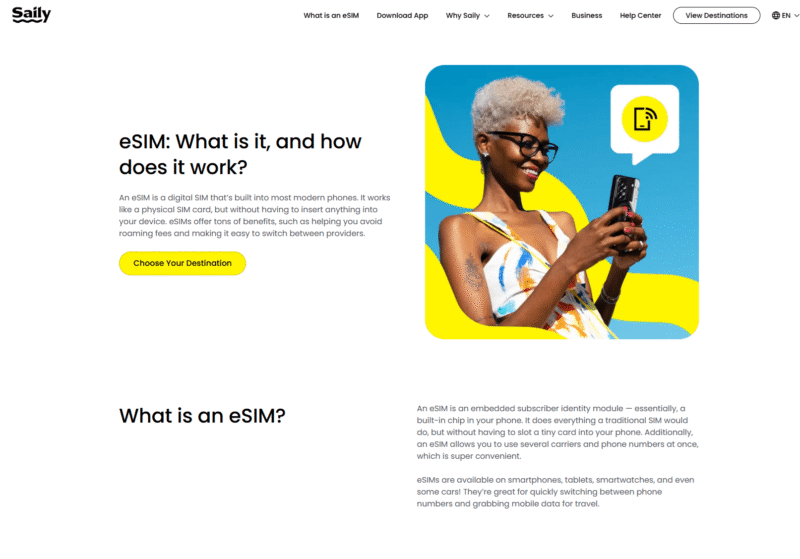eSIM vs International Plan: Which Is Better for Traveling Abroad?
Nothing adds more gloom to the end of a dream vacation than discovering you've racked up a ginormous roaming bill. To discover the most cost-effective and convenient way to use mobile data abroad, check out this eSIM vs international plan comparison.
International roaming fees are a major pain point for any traveler, and anyone who uses a roaming plan is sure to be familiar with the constant worry about “surprise” fees. Travel eSIM plans are a decent solution, but they’ve only just started to gain popularity with everyday travelers. My eSIM vs international plan guide is for those who want to get up to speed.
In this guide, I’ll cover the key differences between international roaming plans and eSIM plans, and share my top tips on choosing the best option for you. To learn more about the top eSIM picks, head over to the Cloudwards best international eSIMs guide.
eSIM vs International Plan at a Glance
Before we get down to business, here’s a quick breakdown of how eSIMs and international plans compare.
| Feature: | eSIM | Global Plan |
|---|---|---|
| Provided By | Travel eSIM brands like Airalo, Saily and Holafly | Your mobile carrier, like Verizon, AT&T or T-Mobile |
| Management | Via the eSIM provider’s app or website | Via your mobile carrier’s app or website |
| Subscription vs One-Off Payment | Usually one-off, but some providers, like Ubigi, have subscription plans | Usually subscription, though some international plan providers also offer day packages |
| Affordability | Usually more affordable | Usually more expensive |
| Typical Starting Price | Varies, typically around $4 for 1GB | Varies, day passes can be around $12, while subscription plans can be $100 per month or more |
| Regular Phone Number Works Abroad? | Yes, you can still use your regular phone number abroad with an eSIM, but you’d incur roaming charges. | Yes |
| International Coverage | Varies by provider or plan, often more than 200 destinations | Varies by provider or plan, often more than 200 destinations |
| Speed | Depends on the partner network and other factors, like location & network congestion | Depends on the partner network and other factors, like location & network congestion |
| Security | More secure | Less secure if using a physical SIM |
| Installation Required? | Yes (easy) | No |
| Compatibility | Most modern iOS & Android devices, including iPhone 11 & above, XS, XR, SE, & various Android models (Google Pixel, Samsung Galaxy, etc.) — older phone models may not support eSIMs | Both eSIM-compatible & purely physical SIM devices |
What Is an eSIM?
An eSIM is a digital SIM card that’s embedded in your phone, allowing you to buy different cellular plans. When you buy an eSIM mobile data plan, you do it via an app or a website and install it directly on your phone using the internet instead of physically inserting a SIM card.
More to the point, travel eSIM providers specialize in mobile data plans (sometimes with call and text functionality) for various countries and regions. You can also usually opt for a global plan. If you’re a beginner, check out our guide on eSIMs.

Pros and Cons of eSIMs
Pros:
- Affordability: Travel eSIM plans are usually more affordable than international roaming plans.
- Great for budgeting: eSIM providers specialize in prepaid plans (though some also offer subscriptions), so you know exactly how much you’re spending.
- Convenience: You can install multiple eSIM profiles on your device and use them as needed.
- Flexibility: eSIM plans offer diverse validity periods, data allowance, plan types and pricing models. Some, like Roamless, let you load funds to an in-app wallet and pay as you go. Others, like Airalo, have data, call and text plans.
Cons:
- Compatibility issues: Most modern phones and some tablets are eSIM-compatible, but there are exceptions, such as iPhones sold in China. In addition, your phone is less likely to support eSIM technology if it isn’t a recent model.
- Device switching problems: With a physical SIM, you can just pop it in another phone, but you can’t do that with an eSIM, which is embedded in your phone and linked to that specific device. This is why eSIM providers urge users to never delete an eSIM profile.
What Is an International Roaming Plan?
An international roaming plan, which you set up via your local mobile carrier (such as T-Mobile, Verizon, etc.), simply lets you make phone calls, send text messages and use mobile data when you travel to other countries. The local mobile carrier partners with networks in other countries.

including monthly subscription packages.
Many international plans are subscription-based and provide a certain amount of data (plus texts and/or phone calls in some cases) for the chosen period.
Pros and Cons of International Plans
Pros:
- No installation: Unlike with an eSIM, you don’t have to install an international plan. You just turn data roaming on and use your phone as normal while overseas.
- Variety of plan types: I found a broad selection of plan types during my research, including short-term plans, long-term plans and plans with varying levels of coverage.
- Keep your usual number: eSIM plans with calling and texting capability assign you a new phone number. With international plans, you just continue to use your regular phone number.
Cons:
- More expensive: International plans can be pricey, with some costing upwards of $100 per month.
- Extra fees: You have to be careful to avoid going over your plan’s data, call or text allowance, as this could result in “surprise” fees. Be sure to scrutinize the fine print on international plans to know exactly what you’re getting.
How to Choose Between an eSIM vs International Plan
The key factors I’d consider if I had to choose between an eSIM and an international plan include cost, coverage, mobile hotspot availability, security and privacy.
What About Purchasing a Local Physical SIM Card?
Local SIM cards are often readily available in airports and places like convenience stores. There’s no setup — you just pop one in your SIM tray and away you go — and local rates in some countries can be really low.
On the flip side, they’re ideal only for one-off trips or trips to one country. If you’re a frequent jetsetter, keeping track of a bunch of tiny chips could soon turn into a major headache. Additionally, bear in mind that local SIM regulations can vary greatly from country to country, so you may experience lengthy registration procedures in some destinations.
The Best eSIM for Travel
If eSIMs have won you over, I recommend checking out these three based on my testing.
Final Thoughts: Our Honest Recommendation
I prefer eSIM plans for traveling abroad because they’re more affordable and flexible, and I like the comfort of always knowing exactly what I’m getting. With eSIM packages, if you run out of data, that’s it; you won’t be slapped with surprise extra fees, which is always a risk with international roaming.
Does an international plan or an eSIM plan work best for you? Which providers do you use, and what has your experience been like? Feel free to share in the comments. Thanks for reading.
FAQ: Physical SIM Cards vs a Prepaid eSIM Plan for Travel
Yes, you can have both an eSIM and a physical SIM in the same device, as long as it supports dual SIM functionality.
You can install up to eight eSIM profiles on an iPhone 15.
Yes, you can use your iPhone in Japan, but I suggest looking into eSIM plans for Japan as opposed to using your home data abroad, which can be really expensive.
Saily is the best eSIM for Europe based on my testing.




